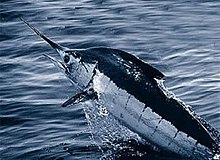
Back Bloumarlyn Afrikaans مرلين أزرق أطلسي Arabic مرلين ازرق اطلسى ARZ Атлантически син марлин Bulgarian Makaira nigricans CEB Marlín modrý Czech Blauer Marlin German Makaira nigricans Spanish Makaira nigricans Basque نیزهماهی آبیرنگ اطلس Persian
| Atlantic blue marlin | |
|---|---|

| |
| Male | |
| Scientific classification | |
| Domain: | Eukaryota |
| Kingdom: | Animalia |
| Phylum: | Chordata |
| Class: | Actinopterygii |
| Order: | Istiophoriformes |
| Family: | Istiophoridae |
| Genus: | Makaira |
| Species: | M. nigricans
|
| Binomial name | |
| Makaira nigricans Lacépède, 1802
| |

| |
| The range of the Atlantic blue marlin | |
| Synonyms | |
|
See below | |
The Atlantic blue marlin (Makaira nigricans) is a species of marlin endemic to the Atlantic Ocean. It is closely related to, and usually considered conspecific with, the Indo-Pacific blue marlin, then simply called blue marlin. Some authorities consider both species distinct.
The Atlantic blue marlin (hereafter, blue marlin) feeds on a wide variety of organisms near the surface. It uses its bill to stun, injure, or kill while knifing through a school of fish or other prey, then returns to eat the injured or stunned fish. Marlin is a popular game fish. The relatively high fat content of its meat makes it commercially valuable in certain markets. It is the national fish of the Commonwealth of The Bahamas and is featured on its coat of arms.
Blue marlin are distributed throughout the tropical and subtropical waters of the Atlantic Ocean. A bluewater fish that spends the majority of its life in the open sea far from land,[2] the blue marlin preys on a wide variety of marine organisms, mostly near the surface, often using its bill to stun or injure its prey. Females can grow up to four times the weight of males. The maximum published weight is 818 kg (1,803 lb) and length 5 m (16.4 ft).[3] Greater lengths have been claimed unofficially.[4]
They are sought after as a highly prized game fish by anglers and are taken by commercial fishermen, both as a directed catch and as bycatch in major industrial tuna fisheries. Blue marlin are currently considered a threatened species by the IUCN due to overfishing,[1] particularly in the international waters off the coast of Portugal where they migrate to breed in the June/July months.[citation needed] Some other historic English names for the blue marlin are Cuban black marlin, ocean gar, and ocean guard.[5]
- ^ a b Collette, B.; Acero, A.; Amorim, A.F.; Boustany, A.; Canales Ramirez, C.; Cardenas, G.; Carpenter, K.E.; de Oliveira Leite Jr.; N.; Di Natale, A.; Die, D.; Fox, W.; Fredou, F.L.; Graves, J.; Guzman-Mora, A.; Viera Hazin, F.H.; Hinton, M.; Juan Jorda, M.; Minte Vera, C.; Miyabe, N.; Montano Cruz, R.; Nelson, R.; Oxenford, H.; Restrepo, V.; Salas, E.; Schaefer, K.; Schratwieser, J.; Serra, R.; Sun, C.; Teixeira Lessa, R.P.; Pires Ferreira Travassos, P.E.; Uozumi, Y.; Yanez, E. (2011). "Makaira nigricans". IUCN Red List of Threatened Species. 2011: e.T170314A6743776. doi:10.2305/IUCN.UK.2011-2.RLTS.T170314A6743776.en. Retrieved 19 November 2021.
- ^ Blue Marlin, National Geographic, archived from the original on 12 June 2007, retrieved 11 November 2008.
- ^ Froese, Rainer; Pauly, Daniel (eds.) (2013). "Makaira nigricans" in FishBase. August 2013 version.
- ^ Obituaries, The Telegraph (22 July 2019). "Colonel Finlay Maclean, Military Knight of Windsor who once caught a 456 lb, 21-foot long blue marlin – obituary". The Telegraph. ISSN 0307-1235. Retrieved 23 July 2019.
- ^ Atlantic Blue Marlin, Florida Museum of Natural History, archived from the original on 26 January 2009, retrieved 29 January 2009
© MMXXIII Rich X Search. We shall prevail. All rights reserved. Rich X Search
